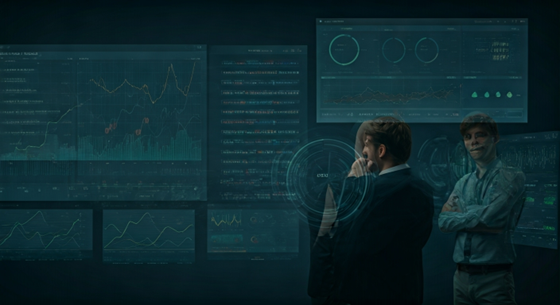Comprehensive Energy Data Management for Your Business

Key Highlights
- Good data management for energy helps you use less energy and can lower your energy costs by a lot.
- When you do careful data collection and use real-time analytics, you boost your operational efficiency and make your workflows better.
- Using advanced software makes energy data clear, helps you see what is going on, and supports smarter decision-making so your business can do well.
- Having solid energy data strategies keeps you in line with rules and helps your sustainability work.
- A plan that uses data changes how people look at energy management, making it a key part of how you run your business.
- If you follow best practices in energy data management, it can have a big effect on your company’s efficiency and success.
Introduction
The global energy industry is changing. Many businesses now work to meet the need for both sustainability and better efficiency. Energy Data Management, or EDM, has a big part to play in this. When companies collect and look at their energy data in a planned way, they can use less energy and reduce spending, positively influencing the company’s bottom line. This also helps them work better overall. No matter if you use EDM for getting good insights about energy consumption, or to follow strict rules, these tools help you stay on track. In this blog, we will look at how data management and tracking energy usage can improve your business and help you make the most of your work for years to come.
Energy Data Management

Understanding Energy Data Management in Modern Businesses
Energy Data Management is key for better energy tracking and control in today's fast-changing business world. It means using data collection and analytics to look at energy data and spot patterns. With these insights, companies can see where there are problems and use these ideas to improve energy usage and shape their goals.
EDM, or energy data management, helps companies in many ways. By tracking energy use in real-time and using analytics, companies get the tools to make their energy use better, cut down on carbon, and follow new rules. The next sections will show how this change helps with optimization and what people and businesses can do with it.
Key Differences Between Energy Data Management and Traditional Energy Management
Energy Data Management (EDM) and traditional energy management both help to lower energy consumption. However, they do this in different ways. Traditional energy management works by putting in place certain ways to save energy and to help with sustainability. This can include things like choosing fuel-efficient vehicles or updating equipment in a building. By doing these things, companies can follow the rules and save money.
On the other hand, EDM is more about data management. This means it looks at how to collect, study, and use energy data to make decisions. EDM tracks how energy gets used over time. It helps to find where energy may be wasted by showing trends in energy usage right when they happen. By using cloud-based tools and analytics, businesses can find out where to save money and improve how things run.
EDM is not like older methods. It uses new tech, such as AI and IoT devices, to get even more insights about energy management. These insights can then turn into clear steps that show real improvements. Moving from old manual ways to modern, data-driven workflows is a big step forward for energy management. This new way is more exact. It helps with energy usage optimization, cost reduction, and greater success in reaching sustainability goals.
The Growing Importance of Data-Driven Energy Strategies
Modern businesses now use data-driven ways to work through the changing world of the energy industry. By looking at energy data with advanced analytics, organisations get helpful information. This can help to make things run better, use less energy, and work in a more sustainable way.
These methods give real results, like finding patterns, spotting waste, and making smart changes. Following best practices also makes sure businesses keep up with regulatory compliance. It helps them be known as responsible leaders in their field. For example, using AI tools with real-time dashboards lets companies make smarter choices for energy planning.
The effects are clear. Companies cut costs, lower their energy consumption, and meet their sustainability goals. All of this is possible by using a system of data-driven tools. When businesses use these methods, they not only get fast results, but also make sure they will stay strong in the fast-moving market focused on energy.
Core Components of Effective Energy Data Management

Good energy data management starts with careful collection, strong checking, and good analytics. When you collect energy data with special sensors and meters, you get real-time tracking of how energy is used in different equipment and work areas.
Checked and trusted data is key. It helps organisations see problems and places where energy is used too much. With smart analytics tools, you can turn simple energy data into useful actions, including the interpretation of energy data. These actions let businesses cut down on energy consumption, save money, and help the environment. In the next part, we will look at helpful ways to handle and understand data even better.
Data Collection, Validation, and Analysis Techniques
Energy data management requires precise techniques for collecting, validating, and analyzing energy information. Continuous monitoring with sensors and IoT devices ensures comprehensive data collection across all equipment.
Validation plays a critical role in ensuring the accuracy of energy readings and messages. Configurable rules automatically detect discrepancies, allowing businesses to create reliable datasets for decision-making. Once data is verified, it’s ready for advanced analysis using tools such as PowerBI or Azure AI, which categorize trends and inefficiencies.
Technique----------------Application
Data Collection----------Real-time monitoring via sensors for tracking energy consumption patterns.
Data Validation----------Automatic quality checks based on rules detect errors in meter values.
Data Analysis-------------Predictive analytics identifies trends, anomalies, and optimization areas.
An integrated approach to these techniques not only reduces errors but also improves transparency and decision-making capabilities.
Leveraging Technology and Software for Real-Time Insights
Today, the use of advanced technology helps businesses get real-time insights into their energy usage. Cloud-native software makes energy data management simple. This software can grow with your company. It is fast, performs well, and ready for powerful AI features.
Key benefits include:
- Enhanced Operational Transparency: Dashboards show what’s happening by giving easy-to-read snapshots of trends.
- Real-Time Monitoring: IoT-enabled devices track energy usage all the time.
- AI-Powered Tools: Analytics tools use AI to predict energy needs and spot where things are not working right.
- Seamless Integration: The software brings together energy data systems with maintenance platforms. This gives you one clear view for better analysis.
With the help of these tools, organisations can spot ways to get better results fast. This helps improve operational efficiency and save money across all their workflows. You also get more transparency in how your energy is used.
Business Benefits of Robust Energy Data Management
Using strong energy data management in a business has many good benefits. With real-time tracking and predictive analytics, you can see how the company uses energy every day. This helps to lower energy consumption. It also makes the work run in a better way and cuts costs in a big way.
Also, this matches up with rules for regulatory compliance and helps with sustainability goals. These are important if you want your company to do well for many years. When a company uses advanced edm systems, it is easier to have more transparency and make good choices. This can help their bottom line look better. Now, let’s look at some clear ways companies can get help from these systems.
Enhancing Operational Efficiency and Cost Savings
Energy data management helps to change the way operational systems work by pushing for better efficiency. It also helps to lower energy consumption that is not needed. Predictive tools can find the peak times your organisation uses the most energy, so you can make smart choices about when and how to adjust workflows or make upgrades.
These tools will show where there are problems in how equipment works. If you swap out old machines for energy-saving ones, you can lower costs in the long run. AI-driven analytics help make these processes even better. They allow businesses to make smarter choices for planning and budgeting.
When you depend on energy data management (EDM) and analytics to keep making long-term improvements, your organisation can save money over the long term. This way, you keep operations running well and use less energy, which fits in with goals for growth for the future.
Meeting Compliance and Sustainability Goals in the United States
Businesses in the US need to follow strict rules for energy efficiency and emissions. Energy Data Management, also known as EDM, is a crucial element that helps companies stay in line with these rules. It involves systematic collection of tools to help you track and understand your energy consumption in a simple way. These systems can also give real-time data, which makes reporting much easier.
When a business starts using EDM for its sustainability work, the benefits can be big. The energy data you get can be acted on right away to help lower your carbon footprint. By matching your energy assessments to your green goals, your company can meet its long-term sustainability plans. This will also make your brand look good to the public.
Taking this kind of early action means you are caring for the environment but also staying competitive in the energy industry. It can also help your business be seen as a leader in this field.
Conclusion
To sum up, strong data management of your energy data is key for any business today. It helps you make your work better and save money. When you gather, check, and look at your energy data the right way, your company can make good choices. This can improve operational efficiency and also help reach your sustainability goals. Having a good plan for energy data management does more than help you follow rules. It shows that your business is ready for what comes next and stands out in a busy market. If you want to use your energy data in the best way, get in touch today. We can help you meet your energy management goals.
Frequently Asked Questions
What types of businesses benefit most from energy data management?
Businesses that use a lot of energy—like those in manufacturing, logistics, and building facilities—can get a lot out of energy data management, a central aspect of energy management. By using energy data better, companies can boost energy efficiency and cut down on costs. EDM helps these industries achieve a significant impact on getting more out of their work while keeping costs lower. This is important for companies that want to get the best out of their operations and save money.
How does energy data management support sustainability initiatives?
Energy data management is very important for any good sustainability plan. By using data on energy usage, companies get helpful insights. These analytics help people in an organisation to follow all rules about regulatory compliance, make workflows better, and reduce carbon emissions at the same time. This is how they reach their goals for sustainability and improve operational efficiency too.
What are the main challenges in implementing an energy data management system?
Businesses often run into problems like high starting costs and tricky data collection. It can be hard to make sure there is transparency in all workflows. In the energy industry, it is important to fit EDM tools into what is already there. This helps the people in the energy industry deal with technical challenges in their workflows, and also helps keep transparency at every step of data collection.
How can energy data management help with regulatory compliance in the US?
EDM helps US businesses follow the rules set by the government. It provides clear energy analytics and easy-to-use reporting tools. By tracking energy usage and making sure workflows work well, organisations can lower costs. At the same time, they meet federal guidelines for emissions and energy efficiency. This way, EDM supports companies with both regulatory compliance and better energy savings.
What should businesses look for when choosing an energy data management solution?
Organizations need to focus on using EDM solutions that have strong analytics. The system should be easy to connect with other tools. It is important that reporting is clear, with full transparency. The EDM system should also follow the best practices for energy efficiency. Having real-time insights and the ability to grow the system are key for good data management of energy data.
What is energy data management and why is it important?
Energy data management involves collecting, analyzing, and optimizing energy consumption data to enhance efficiency and reduce costs. This process is crucial for businesses aiming to lower their carbon footprint, comply with regulations, and make informed decisions regarding energy usage, ultimately leading to significant savings and sustainability improvements.



